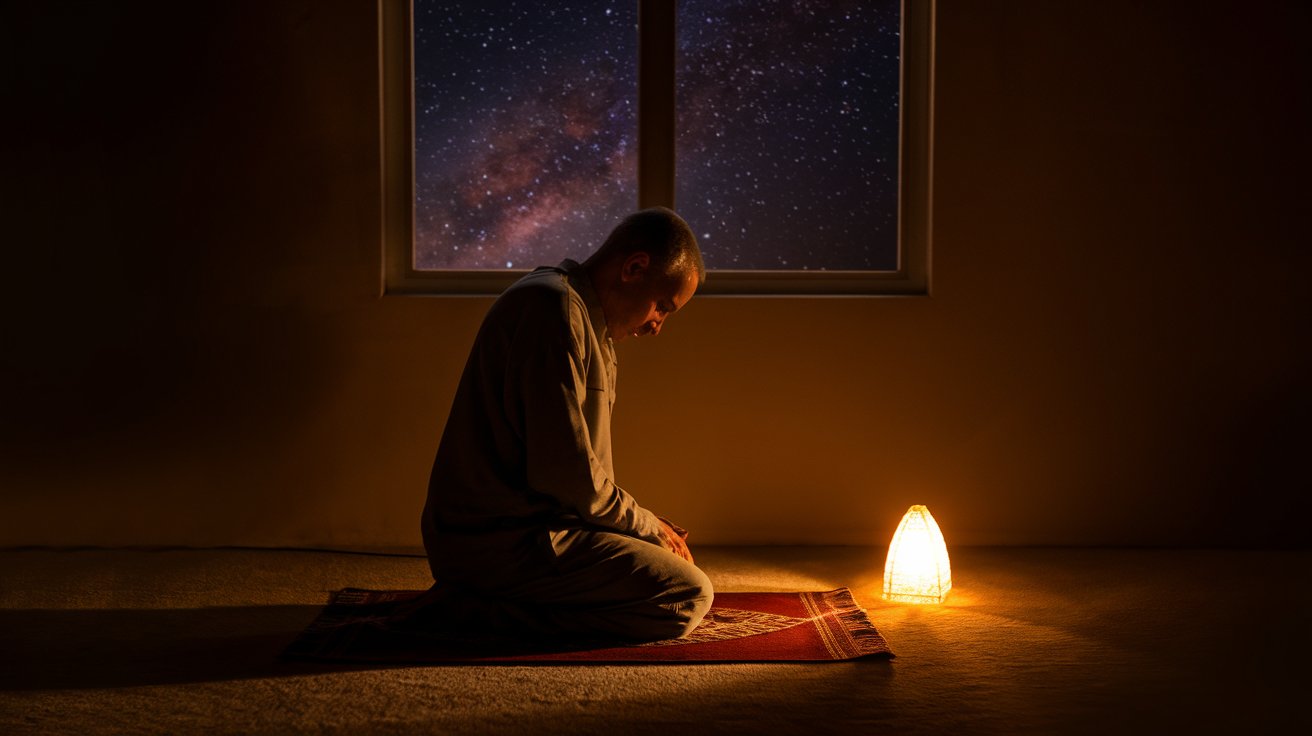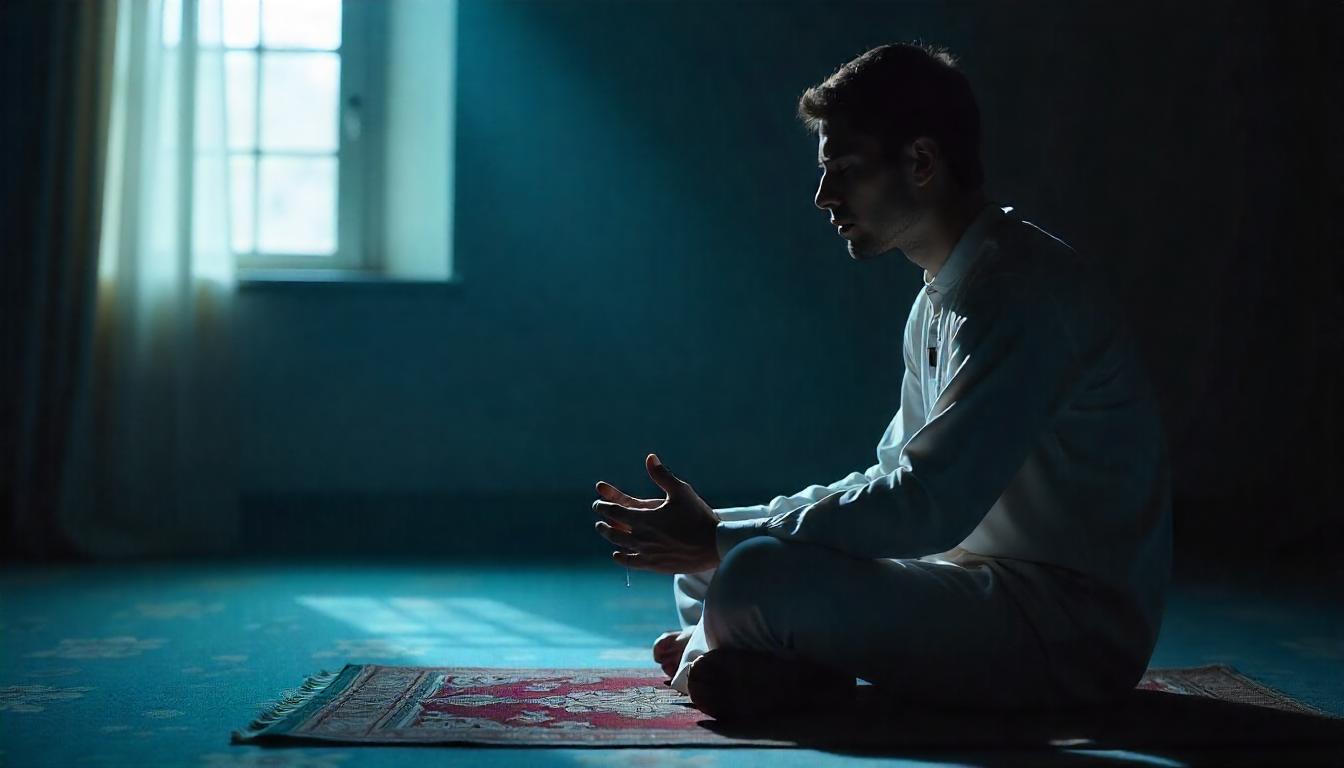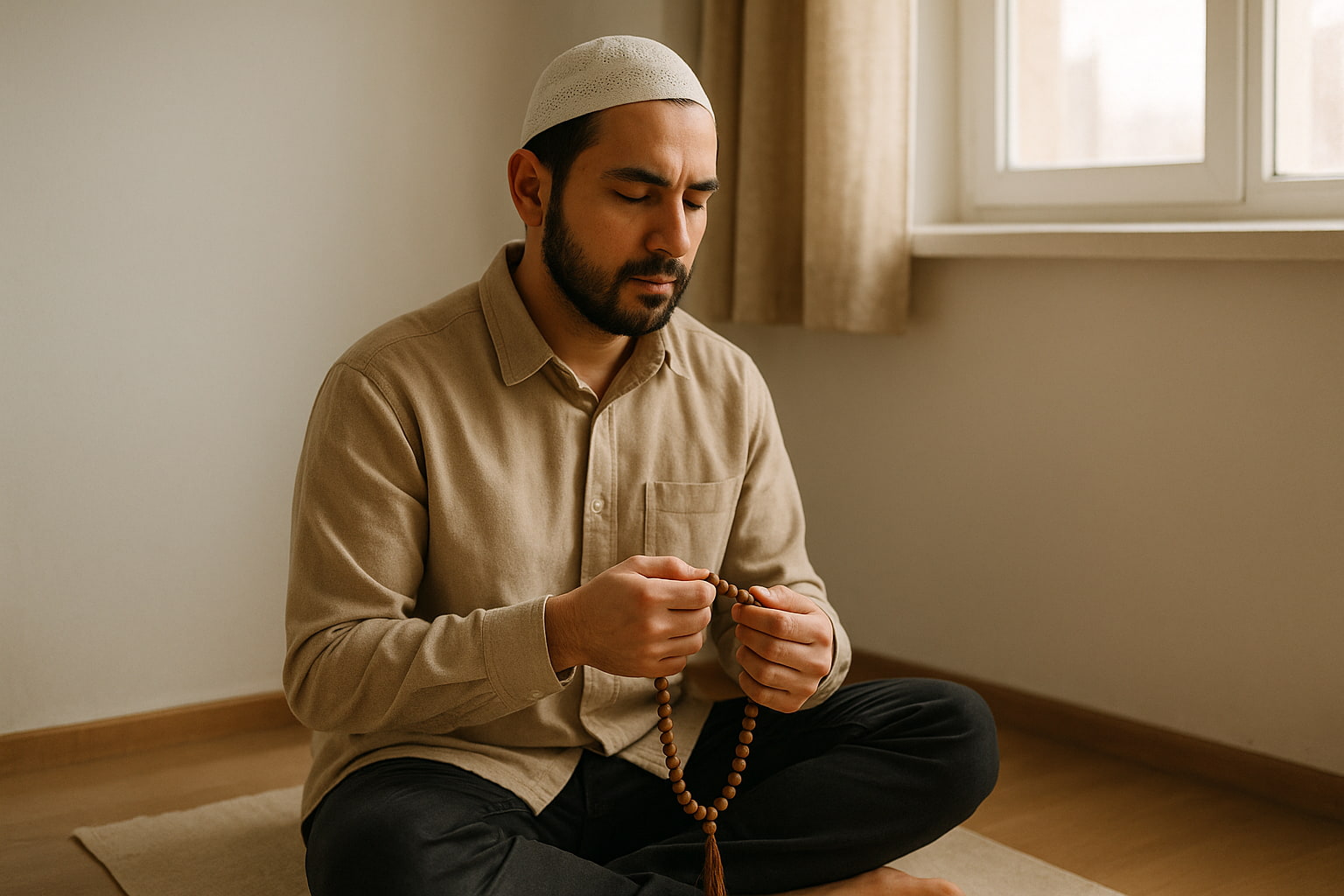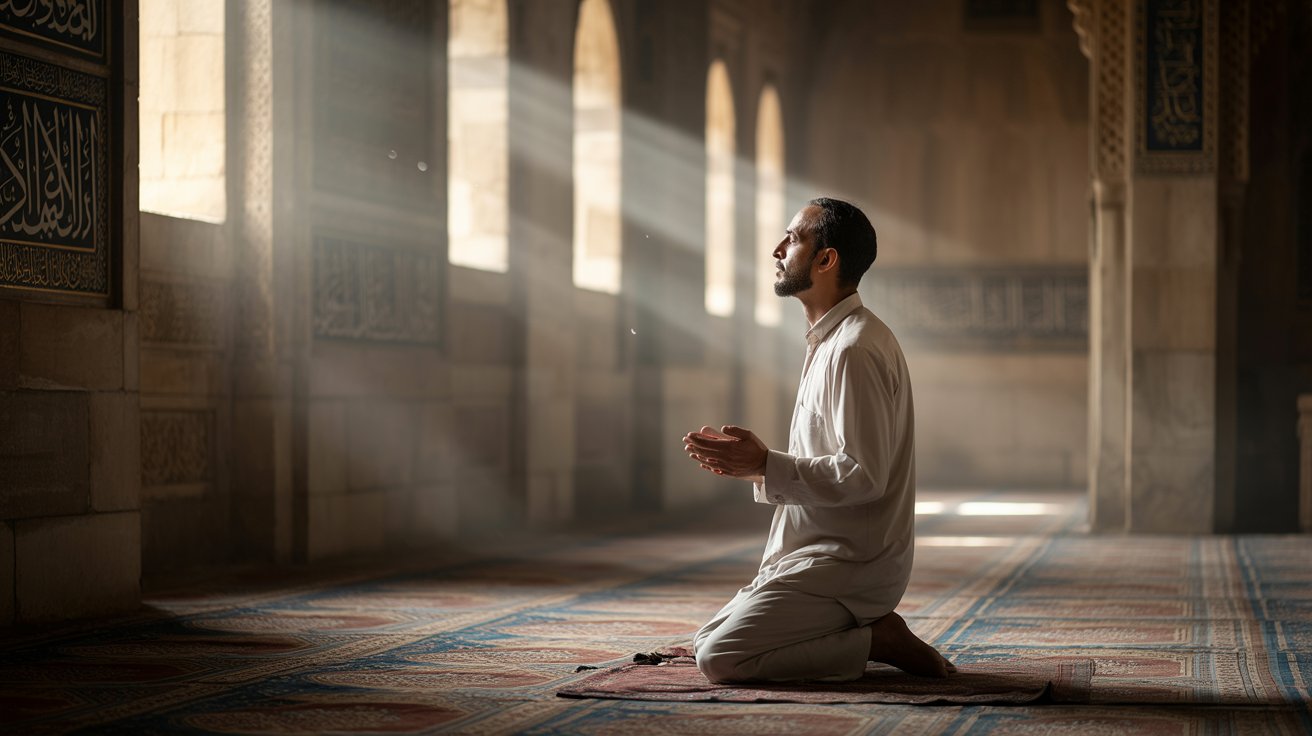Imagine the king of kings is calling out to you every night, asking who will call upon me I’ll answer? Who will seek from me so I may give? Who will seek forgiveness so I may forgive? And yet, we sleep through it as if we’re not the ones in need.
Discover the Power of Tahajjud
Are you struggling to find peace in a chaotic world? Between the demands of work, family, and daily life, it’s easy to feel overwhelmed and disconnected from your spiritual core.
What if there was a way to carve out a sacred space in your day—or rather, your night—to reconnect with Allah, seek forgiveness, and find inner tranquility? Enter Tahajjud, the voluntary night prayer that has been a solace and strength for Muslims throughout history.
A Nighttime Prayer That Brings Peace, Forgiveness, and Spiritual Growth
Let’s learn about Tahajjud: its meaning, historical roots, spiritual significance, and practical steps to incorporate it into your life. Whether you’re a new convert, a seasoned Muslim looking to deepen your practice, or someone unfamiliar with Tahajjud, this guide is for you.
What is Tahajjud?
Tahajjud, derived from the Arabic root hajada (meaning “to stay awake at night”), is a voluntary night prayer performed after the obligatory Isha prayer and before Fajr. It’s often referred to as the “night vigil” and is a profound act of worship that allows believers to stand before Allah in the stillness of the night.
While Tahajjud is not obligatory, it holds a special place in Islamic tradition as a Sunnah Mu’akkadah (a highly recommended practice) of the Prophet Muhammad (peace be upon him). It’s distinct from Qiyam-ul-Layl (general night prayer) and Tarawih (the special night prayers during Ramadan). Tahajjud is deeply personal, offering a unique opportunity for self-reflection, dua (supplication), and spiritual growth.
Why Pray Tahajjud?
The benefits of Tahajjud extend far beyond the spiritual realm. Here’s why this night prayer is so transformative:
Closeness to Allah
The Quran describes the night as when the soul is most receptive to divine connection.
In Surah Al-Muzzammil (73:6), Allah Says,
إِنَّ نَاشِئَةَ اللَّيْلِ هِيَ أَشَدُّ وَطْئًا وَأَقْوَمُ قِيلًا
“Indeed, the hours of the night are more effective for concurrence [of heart and tongue] and more suitable for words.”
Mental Clarity and Discipline
Waking up in the quiet of the night enables mindfulness, gratitude, and a sense of purpose.
Dua Acceptance
The last third of the night is a blessed time when duas are more likely to be answered.
Historical Roots of Tahajjud
Quranic Foundations
The Quran repeatedly emphasizes the significance of night prayer:
1. Surah Al-Isra (17:79)
وَ مِنَ اللَّيْلِ فَتَهَجَّدْ بِهِ نَافِلَةً لَّكَ عَسَىٰ أَن يَبْعَثَكَ رَبُّكَ مَقَامًا مَّحْمُودًا
Wa minal-layli fatahajjad bihi nafilatal laka ‘asa any yab’athaka rabbuka maqamam mahmuda.
Translation
“And from [part of] the night, pray with it as additional [worship] for you; your Lord may raise you to a praised station.”
2. Surah Al-Muzzammil (73:1-4)
يَا أَيُّهَا الْمُزَّمِّلُ (1) قُمِ اللَّيْلَ إِلَّا قَلِيلًا (2) نِّصْفَهُ أَوِ انقُصْ مِنْهُ قَلِيلًا (3) أَوْ زِدْ عَلَيْهِ وَرَتِّلِ الْقُرْآنَ تَرْتِيلًا (4)
Ya ayyuhal-muzzammil (1). Qumil-layla illa qalila (2). Nisfahu awinqus minhu qalila (3). Aw zid ‘alayhi wa rattilil-qur’ana tartila (4).
Translation:
“O you who wraps himself [in clothing] (1), arise [to pray] the night, except for a little (2) – half of it or subtract from it a little (3) or add to it, and recite the Quran with measured recitation (4).”
3. Surah Al-Furqan (25:64)
وَالَّذِينَ يَبِيتُونَ لِرَبِّهِمْ سُجَّدًا وَقِيَامًا
Wallazeena yabeetoona li rabbihim sujjadan wa qiyama.
Translation:
“And they who spend the night in prostration and standing [in prayer] before their Lord.”
Prophetic Tradition
The Prophet Muhammad (peace be upon him) was a living example of devotion to Tahajjud. He said, “The best prayer after the obligatory ones is the night prayer.” (Sahih Bukhari 1121). Even during travel or difficult times, he maintained this practice, demonstrating its importance.
Pre-Islamic Legacy
Night prayer was also practiced by earlier prophets, such as Dawud (AS), who would spend half the night in worship. The Sahaba (companions of the Prophet) like Umar ibn al-Khattab and Ali ibn Abi Talib were known for their dedication to Tahajjud, often prioritizing it over sleep.
When is the Best Time for Tahajjud?
The ideal time for Tahajjud is the last third of the night, which is calculated by dividing the time between Isha and Fajr into three equal parts. For example, if Isha is at 8 PM and Fajr at 5 AM, the last third would begin around 2 AM.
However, Tahajjud can be performed anytime after waking up from sleep, even if it’s just a brief nap. It’s important to note that Tahajjud is invalid after Fajr begins.
Preparing for Tahajjud
Set Your Intention (Niyyah)
Sincerity is key. You don’t need to verbalize your intention; simply focus on seeking Allah’s pleasure.
Sleep Hygiene
Go to bed early after Isha to ensure you’re well-rested. Recite the dua for sleeping:
“بِاسْمِكَ اللّهُمَّ أَمُوتُ وَأَحْيَا”
(In Your name, O Allah, I die and I live).
Waking Up
Use an alarm or ask a family member to wake you. Place your alarm across the room to avoid hitting snooze!
Physical Preparation
Perform wudu (ablution) and find a quiet, clean space for prayer.
Step-by-Step Guide to Praying Tahajjud
1. Rak’ahs
Tahajjud can be prayed in a minimum of 2 rak’ahs and a maximum of 12, all performed in pairs.
2. Recitation
Recite short or long Surahs. The Prophet (peace be upon him) often recited Surahs like Al-Kafirun, Al-Ikhlas, and Al-Ala.
3. Witr
After Tahajjud, you may pray Witr, which consists of 1 or 3 rak’ahs.
Example Dua
رَبَّنَا آتِنَا فِي الدُّنْيَا حَسَنَةً وَفِي الْآخِرَةِ حَسَنَةً وَقِنَا عَذَابَ النَّارِ
(O our Lord, give us in this world good and in the Hereafter good and protect us from the punishment of the Fire.)
Recommended Duas and Surahs
- Surahs- Al-Ala, Al-Nas, Al-Falaq, Al-Kafirun, Al-Ikhlas.
- Duas- Seek forgiveness (Astaghfirullah), guidance (Rabbishrahli sadri), and gratitude (Alhamdulillah).
Common Mistakes to Avoid
- Praying before Isha or too close to Fajr.
- Overcomplicating the prayer with lengthy recitations.
- Neglecting consistency due to perfectionism.
Overcoming Challenges
- Staying Consistent
Start small with 2 rak’ahs and gradually increase. Find an accountability partner.
- Falling Back Asleep
Splash water on your face or sit while praying if you’re too tired.
- Making Up Missed Prayers
Scholars differ on whether missed Tahajjud can be made up, but focus on consistency rather than perfection.
Tahajjud and Women
- During menstruation, women cannot pray Tahajjud but can engage in dhikr and dua.
- Mothers and homemakers can balance night worship by involving family members or praying during quieter moments.
The Science and Spirituality of Night Prayer
- Health Benefits
Night prayer aligns with the body’s natural sleep cycle, promoting restful sleep and reducing stress.
- Psychological Impact
The act of waking up to pray encourages gratitude, emotional resilience, and a sense of purpose.
FAQs
✓ Can I pray Tahajjud without sleeping first?
Yes, but it’s preferable to sleep first to align with the Sunnah.
✓ How many rak’ahs are required?
There’s no fixed number, but the Prophet (peace be upon him) often prayed 8 rak’ahs.
✓ What if I miss Tahajjud? Can I pray it later?
While Tahajjud is time-specific, you can make up for it by praying Qiyam-ul-Layl.
✓ Is Tahajjud valid during Ramadan?
Yes, but it’s often combined with Tarawih prayers.
✓ Can I pray Tahajjud sitting down due to fatigue?
Yes, if standing is difficult, you can pray while sitting.
Transform Your Nights into a Sacred Journey and Connection with Allah
Start small tonight. Set your alarm, make your intention, and pray just 2 rak’ahs of Tahajjud. Track your progress and reflect on the spiritual and emotional changes you experience. Remember, consistency is more important than perfection.










